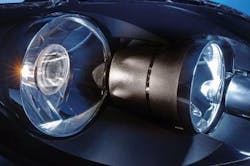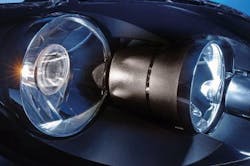A team of researchers from the Fraunhofer Institute for Laser Technology (Fraunhofer ILT; Aachen, Germany), the Fraunhofer Institute for Organic Electronics, Electron Beam, and Plasma Technology (Fraunhofer FEP; Dresden, Germany), and the Institute of High Frequency Technology (IHF) at RWTH Aachen University (also in Aachen) has developed a coating process that enables radar sensors to be integrated in car headlights. The partners in the joint research project RadarGlass, funded by the VDI/VDE as part of the "VIP+" initiative under the code 03VP03201, have applied for a patent for an innovative radar system. After almost two years in development, they have manufactured a working prototype.
There is a challenge for sensor technology in completely autonomous vehicles because the supporting system must hear, see, and feel better than humans. While the corresponding sensors are available—since a large number of assistance systems have already been installed—developers are faced with the question of where they can be best placed. In the case of radar sensors, it makes sense to install them in the front headlamps a perfect position because they completely cover the near and far range and allow drivers to look to the side.
With an electrically conductive thin film for headlamp covers, radar beams can be specifically shaped and directed. (Copyright: Fraunhofer ILT, Aachen, Gerrmany)
"Since the light source generates so much heat, the sensors are also always free of snow and water even under harsh weather conditions," says Patrick Gretzki, scientist in the Micro and Nano Structuring group at Fraunhofer ILT.
With the necessary expertise for developing a suitable coating system to designing the high-frequency components all the way to precisely producing them with laser radiation, the three institutes have developed a functional, electrically conductive thin film placed inside the headlamp cover, a film that can be used to specifically shape and direct the radar beam. The laser can selectively manipulate the beam, depending on the type of application: to detect and recognize pedestrians, the radar beam is directed to the side. Like an eye, the beam can also be focused on the near or far range. The RadarGlass project is investigating which thin-film system can be used to control radar waves with low loss and without limiting the main purpose of the headlamp.
In the RadarGlass joint project, three partners are developing a patented technology for the integration of radar sensors in front headlamps. (Copyright: Fraunhofer ILT, Aachen, Germany)
The partners have developed a coating system that meets the criteria for headlamp and radar use and that can be applied and structured on typical automobile headlamps. To guide and shape the radar beam, small patches of the coating have to be structured. These patches act as small antennas for the radar waves. In a preliminary study, the structuring of antenna elements was utilized to make it possible for high-frequency waves to pass through thermal glazing selectively—for example, the glazing can be used for WLAN and mobile radio networks. The laser-manufactured structures—with a resolution of up to 10 µm—are much more precise than any conventional printing process. Moreover, conventional lithography processes require more steps in the process chain and are limited to flat (or slightly curved) surfaces—two hindrances overcome by the new laser-based process.
With the help of simulations, the partners are developing structures for the targeted manipulation of radar waves in the range around 77 GHz. Using demonstrators, they will show the functionality of the technology and then continue to develop it. Currently, they are presenting the solution to industry representatives to tackle further steps to exploit the process. In the next phase of the project, they will install the solution in real headlamps.
For more information, please visit ilt.fraunhofer.de.


